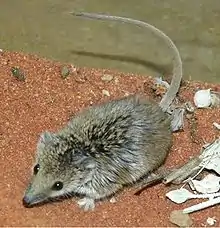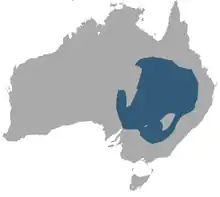Narrow-nosed planigale
The narrow-nosed planigale (Planigale tenuirostris) is a species of very small marsupial carnivore of the family Dasyuridae.
| Narrow-nosed planigale[1] | |
|---|---|
 | |
| Scientific classification | |
| Kingdom: | Animalia |
| Phylum: | Chordata |
| Class: | Mammalia |
| Infraclass: | Marsupialia |
| Order: | Dasyuromorphia |
| Family: | Dasyuridae |
| Genus: | Planigale |
| Species: | P. tenuirostris |
| Binomial name | |
| Planigale tenuirostris Troughton, 1928 | |
 | |
| Narrow-nosed planigale range | |
Taxonomy
The narrow-nosed planigale was described by Ellis Le Geyt Troughton in 1928, separating it from the common planigale (P. maculata) with which it had previously been associated. The scientific name for the species means "slender-snouted flat-weasel".[3]
Description
Planigales are small rodent-like marsupials no greater than 7.5 cm, and weighing less than 10 g.[4] The narrow-nosed planigale differs from other planigales in its more rufous colouring and smaller size – only the long-tailed planigale is smaller. It is an active hunter of various invertebrates,[5] and is known as a fearless and pugnacious predator.[3] Its flattened head is used as a wedge to prize apart grass stems and turn over leaves in the leaf litter. It will often attack prey larger than itself.
Ecology & behaviour
Diet
The narrow-nosed Planigale are generalist insectivores, able to thrive and with a diet that reflects the available prey of their environment.[6] Their diet mostly consists of arthropods including beetles, centipedes and spiders, but can also include reptiles such as small lizards.
Habitat
The narrow-nosed Planigale prefers an open less densely vegetated area (Read, 1987).[6] They can often be found in tussock grassland and low shrubland with cracking clay soils so as to inhabit the soil cavities. (Moss, 1988)[7] Plant height has also been recorded as positively associated with an abundance of P. tenuirostrist.[6]
Behaviour
Unlike other Planigale species, the narrow-nosed Planigale is nocturnal in both summer and winter (Read, 1989)[8] spending only minimal bursts of activity. Research has recorded past short-term activity cycles as 1 hr 25 min in summer and 2 hr 56 min in winter (Read, 1989)[8] Narrow-nosed Planigale surface from the cracks to hunt during the night or stay within these cracks clinging to the vertical sides.[4]
Lifecycle & reproduction
Breeding season runs from July to Mid-January and coincides with food availability during Spring & Summer (Read, 1984). Females have 12 teats and a pouch. Females reach their sexual maturity (for reproduction) on average at 240 days. Females are only in heat (Estrus) for one day, on a 33-day cycle (Read, 1985). In males, the process of sperm production (spermatogenesis) begins in July and ends the following March(aspermatogenesis). The average gestation period lasts just 19 days. The young detach from the teats at a month after birth and mothers begin weaning the young at three months (Read, 1985)[9] In captivity females give birth to two litters with an average of six young annually,[10] but in the wild it is more likely only a single litter will be produced (Read 2008).[11]
Threats to survival
Population densities tend to fluctuate from year to year, however, despite some declines in distribution, this species appears stable.[4]
Habitat degradation
There appear to be no major or widespread threats to the narrow-nosed Planigale species. Localised threats and population declines occur in the form of habitat conversion or destruction, particularly for agricultural use.[12]
Predators
As a result of its habitat (below ground) and hunting habits (within soil cracks), it is protected from most larger predatory species (Moss, 1988).
Changes in rainfall
Research has postulated that fluctuations in rainfall affect the populations of Planigale gilesi and P. tenuirostris (Read, 1988),[7] however little other research has been done into this to confirm whether it is rainfall alone, or the byproduct effect on resources.
Distribution
The narrow-nosed planigale is found in New South Wales, Queensland, South Australia and the Northern Territory in a wide range of inland habitats.[5] It prefers areas with cracked clay soil.
References
- Groves, C. P. (2005). Wilson, D. E.; Reeder, D. M. (eds.). Mammal Species of the World: A Taxonomic and Geographic Reference (3rd ed.). Baltimore: Johns Hopkins University Press. p. 37. ISBN 0-801-88221-4. OCLC 62265494.
- Ellis, M.; van Weenen, J. & Burnett, S. (2008). "Planigale tenuirostris". IUCN Red List of Threatened Species. 2008. Retrieved 28 December 2008.CS1 maint: ref=harv (link)
- Read, D. G. (1995). "Narrow-nosed Planigale". In Strahan, Ronald (ed.). The Mammals of Australia. Reed Books. pp. 113–115. ISBN 0-7301-0484-2.
- Atlas of Living Australia. http://bie.ala.org.au/species/Planigale%20tenuirostris
- Menkhorst, Peter (2001). A Field Guide to the Mammals of Australia. Oxford University Press. p. 64. ISBN 0-19-550870-X.
- Read, D. 1987. Diets of sympatric Planigale gilesi and Planigale tenuirostris Marsupialia Dasyuridae relationships of season and body size. Australian Mammalogy, 10(1-2): 11-22.
- Moss, G., D. Croft. 1988. Behavioral mechanisms of microhabitat selection and competition among three species of arid zone Dasyurid marsupial. Australian Journal of Ecology, 13(4): 485-494.
- Read, D. 1989. Microhabitat separation and diel activity patterns of Planigale gilesi and Planigale tenuirostris Marsupialia Dasyuridae. Australian Mammalogy, 12(1-2): 45-54
- Read, D. 1985. Development and growth of Planigale tenuirostris Marsupialia Dasyuridae in the laboratory. Australian Mammalogy, 8(1-2): 69-78.
- Animal Diversity Web. Planigale tenuirostris. (http://animaldiversity.org/accounts/Planigale_tenuirostris)
- READ, D. G. 2008. Giles’ planigale. pp. 107–109 in The mammals of Australia (S. Van Dyck and R. Strahan, eds.). Reed New Holland, Sydney, Australia.
- International Union of Conservation of Nature. Planigale tenuirostris. http://oldredlist.iucnredlist.org/details/40536/0
